I turned off the lights to the small room in Telegraph Cove, Vancouver Island, plunging it into a blackness that is rarely found in an electric world. The blackness cradled me into a deep sleep, only to be rattled awake a couple of hours later, by a wall of sound. Torrential rain was lashing the window, and drumming on the roof. This was not a good omen for the day ahead, that I was to spend on a small boat, in search of a true North American idol, the Grizzly Bear.
Morning arrived, and my sense of doom was heightened as I watched little rivers snaking down the window pane, under a charcoal sky. I dressed for rain and warmth and walked to the boat. The Skipper was shaking his head and making offers of a full refund; “too much rain, we probably won’t get the boat up the river to where we have been seeing bears”. I had traveled for this trip and this was my one shot. It was a lot of money, but the opportunity was priceless. I told the Skipper that if he goes, I will go and so it was that a small group accelerated out from the comfort of the harbour, and powered towards Knight Inlet, British Columbia.
The journey was long; 85 kilometers (52 miles) through some of the most breathtaking scenery, and richest waters on the planet. We left the shores of Vancouver Island behind us and closed in on mainland Canada. Miraculously, we slowly moved out of the rain, as grey clouds became white, splitting open to tease us with shards of blue.

Sea birds were numerous, and to our port-side a blast of mist filled the air as a humpback whale broke the surface. The boat slowed, and soon our wake was surfed by Pacific White-sided dolphins, bursting from the ocean. Just when we thought we had been blessed enough, the Orcas arrived with their huge, black dorsal fins slicing through the water like a hot knife through butter.
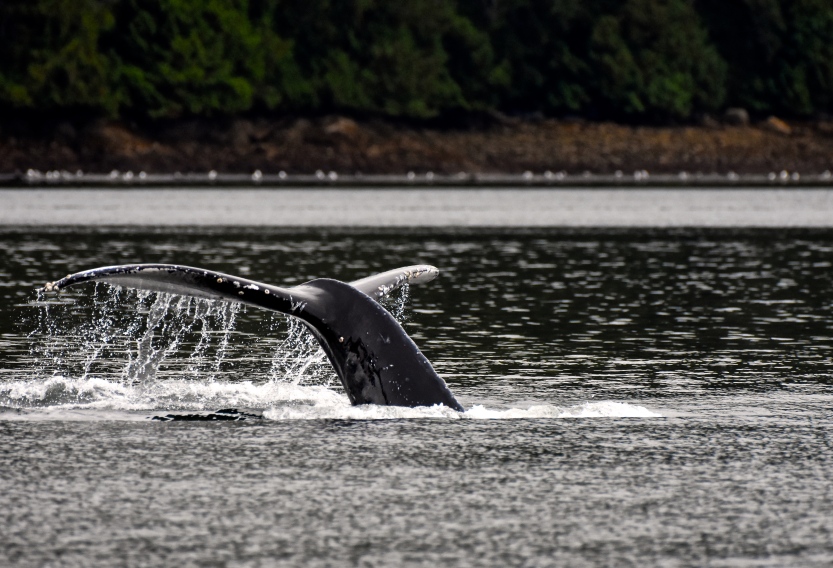
This is how the journey continued for the next couple of hours, until the boat slowed to a chug as we drifted into Glendale Cove river estuary. We docked against a floating pontoon, where a smaller, open skiff was moored. We took the opportunity for a quick bite to eat before climbing aboard the skiff.


The skiff trudged towards the river mouth at the southern boundary of the Great Bear Rainforest. This huge expanse of Pacific temperate rainforest stretches for over 400 kilometers (250 miles), covering an area of 8.4 million hectares (21 million acres) of British Columbia’s coastline, including a network of off-shore islands. There are no roads into this dense wilderness, making boat travel the only way to enter this ecological wonderland that forms part of the largest temperate rainforest on earth.
Nearing the river mouth, there was no sign of bears, but the grasslands were alive with migratory Canada geese. Harbour seals cruised beneath the surface of the water and dozens of majestic Bald eagles circled opportunistically above, in search of salmon carcasses.
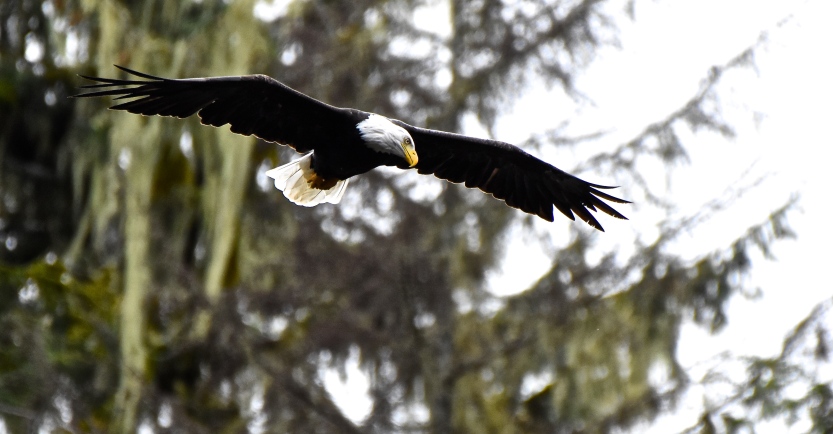
The call goes up; we catch a glimpse of a Grizzly bear ambling from behind a dense tree, through the long grass, towards another dark fir bush. This is the truly remarkable moment that I have long waited for. The Grizzly bear is the stuff of adventure movies and nightmares, a creature to be feared, the largest land predator, a magnificent beast!
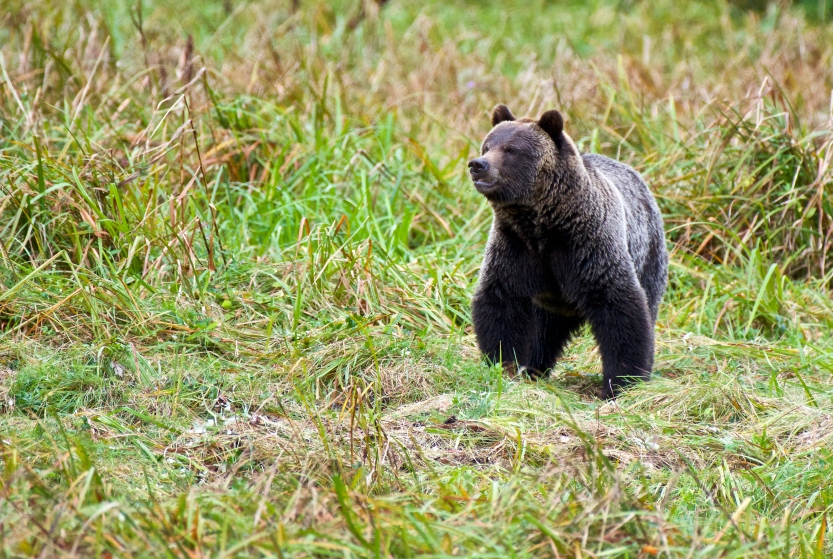
As quickly as the bear appeared, it disappeared, but I was satisfied. If I never see another bear, I am content in the knowledge that I have set eyes on a wild Grizzly, roaming free in her natural habitat.
The water was shallow, too shallow to drive the boat up river. Fortune was on our side as the rain hadn’t made the river unmanageable, as predicted. As the water level inched up with the rising tide, our Skipper and guide jumped out of the boat into almost waist-deep water, one taking the front, the other taking the back, and walked against the flow to silently man-handle the boat up river.
Silently and slowly we moved forward to the gentle music of the river jingling against the hull of the skiff. We came to the first bend in the river, where a huge Grizzly shoulders nonchalantly into the water just a few meters in front of us. My heart stops, freezes for a moment, and then thumps worryingly fast as I realise how close I am to this massive animal, and how shallow the water is. Naively, I had assumed that I would watch Grizzlies on land from the safety of a boat but now, in the centre channel, I am in exactly the same depth of water as the Grizzly, who isn’t even knee deep!
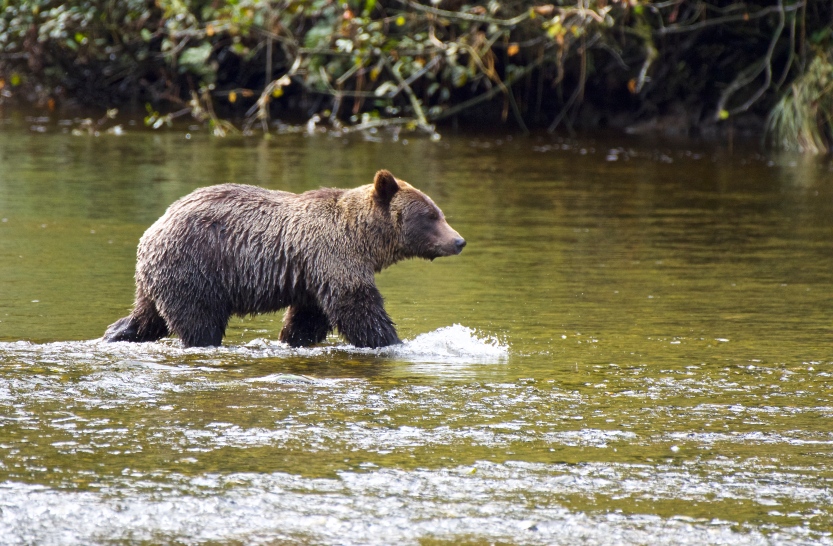
She glanced over at us. Her senses were sharp, much sharper than ours, and she knew that we were there, how many of us we were, and how we would have tasted. She also knew that it would be a waste of her time and energy to even consider an attack, when the back end of the annual salmon run is gifting her an endless stream of nutritious fish carcasses without the need to expend any energy at all.

The British Columbia annual salmon run is a major event on the calendar for bears, eagles, wolves and marine mammals. It is in fact, the engine that drives the Great Bear Rainforest. Beginning in the late summer months and continuing through autumn into early winter, hundreds of thousands of Chinook, Chum, Coho, Pink and Sockeye salmon fight their way up river to spawn. Having reproduced, the salmon die, filling the rivers with nutritious carcasses that require very little effort to pick up and devour. The bears gorge themselves in preparation for hibernation through the long, icy Canadian winter.
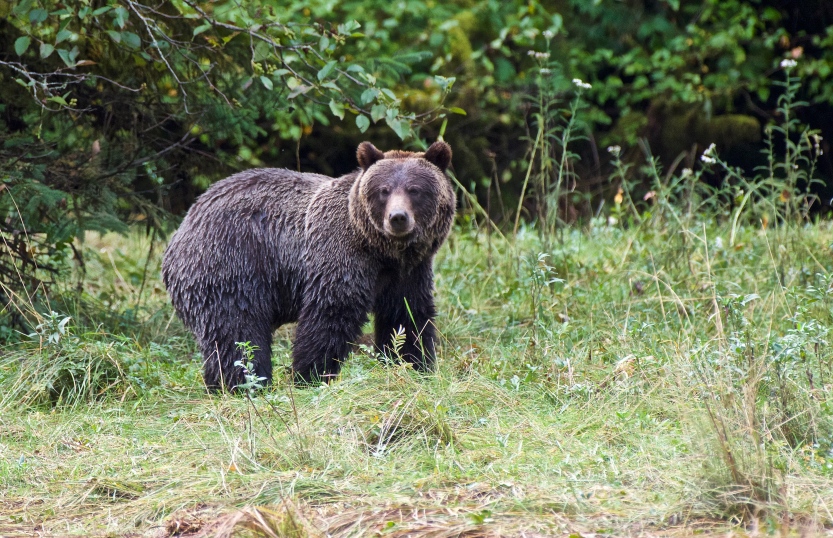
The bear moved up onto the grassy banks where she began to dig for roots. It appears that the bears supplement their salmon diet with roots at this time of year, when the roots nutritional value increases, as plants prepare to survive winter. Finally she ambled off into the distance and we continued our journey up-river.
As the river narrowed to a winding, faster flow, we found ourselves surrounded by trees. The inside bends gave rise to shallow gravel beaches that fall away into deep, slower moving outer bends. We approached another twist in the river and caught sight of a bear on the stony beach. We froze, and the bear seemed to melt into the bushes behind her. We waited, noiselessly for what seemed an eternity, when suddenly the wait was rewarded, and what a reward!

The huge bear swam around the corner, with just her back, eyes and top of her head showing. She dipped her head under, searching for food as she swam to the deeper, outer bend. Standing on the river bed, she shook her massive head. She watched us for a moment and then got back to the serious business of searching for dying salmon.

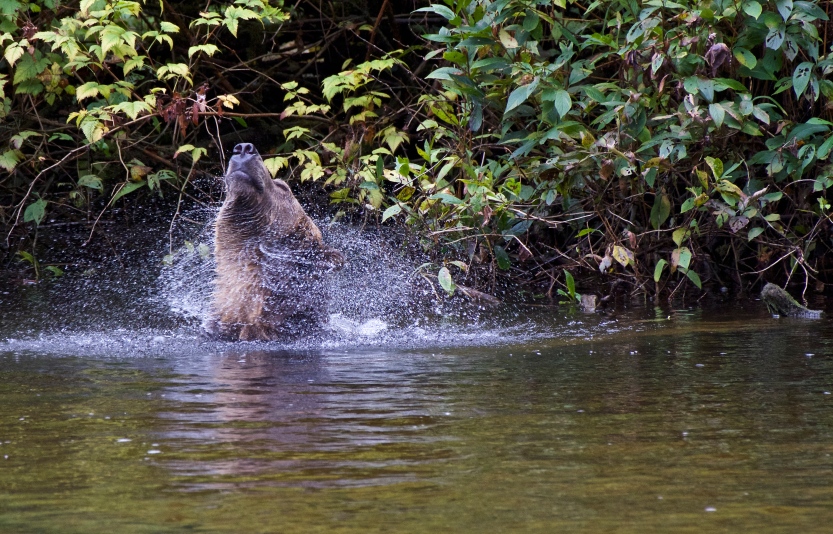
She jerked her head under the surface before sitting up, victoriously with the unmistakable, speckled tail of a fat Pink salmon clenched in her powerful jaws. She wasted no time in tearing the flesh apart and chomping noisily on the freshest sashimi lunch. A group of gulls waited patiently a few meters down stream, hoping for a morsel of flesh to escape her jaws or claws.
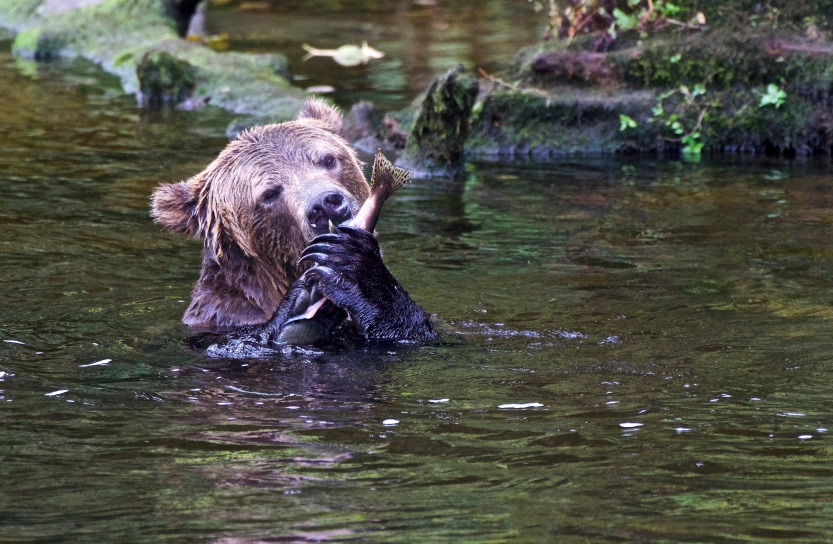

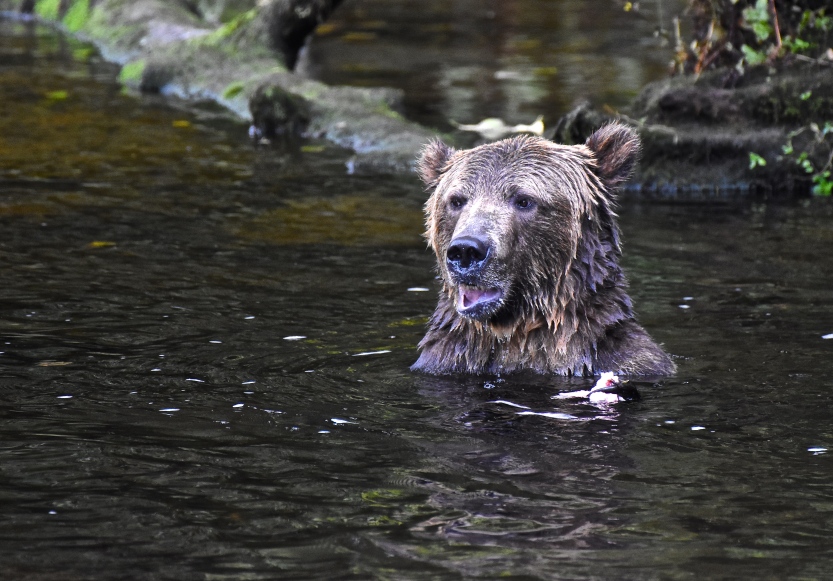
Having devoured the salmon, she got back to swimming, letting the flow take her downstream before disappearing from sight. A short while later another bear stepped to the water’s edge, studied the underwater scene before sliding in to begin the same search for salmon.

The Grizzly bear is a massive animal, with females growing to 800 lbs. and males up to 1,700 lbs. The apex predator has no natural enemies, other than humans, and can live to 25 years old in the wild. There are approximately 55,000 Grizzlies remaining in the wild, 30,000 of which live in Alaska, around 15,000 in British Columbia and the rest scattered across Canada, Montana, Wyoming, Washington and Idaho. Numbers continue to decline each year.
First Nations people have lived in harmony with Grizzlies, and acted as guardians of the Great Bear Rainforest for over 10,000 years. Over these thousands of years, the Grizzly bear has been revered as an ‘Elder Kinsman’ across British Columbia. In the space of less than 300 years, European settlers have pushed the Grizzly to the brink. Firstly by fur hunters, and ranchers. More recently as a result of habitat destruction and trophy hunting, and now the demand for timber, oil and natural gas threatens the future of this pristine environment. The preservation of these lands has to be a priority, not just for Canada but for the whole world. It would surely be a global tragedy to allow this unique ecosystem and the great Grizzly bears that roam within, to succumb to our endless greed for natural resources.
Responsible eco-tourism can help support the preservation of these lands as well as providing a real bucket-list experience. I booked my day-trip through TideRip Grizzly Bear Tours, who I found to be knowledgeable and thoughtful. In preparation for an early morning start, I found that Telegraph Cove Marina provided clean, simple, and affordable overnight accommodation.
For more information on conservation and promotion of economic alternatives in the Great Bear Rainforest visit – Rainforest Solutions Project
We reached the point in the river where the water was too shallow and the flow too fast for our skiff to continue. The current turned the boat, taking us noiselessly, back down river. Once again, as we approached a bend in the river we were treated to the sight of yet another Grizzly, wading out to deeper water, right in front of us. There was no fear or apprehension on the boat. This creature isn’t the stuff of nightmares or the villain of adventure movies. It is an extraordinarily beautiful animal, struggling to survive in an overcrowded world. A creature that has much more interest in swimming, fishing and minding its own business than it has in murder and mayhem. I took my final trophy shot!
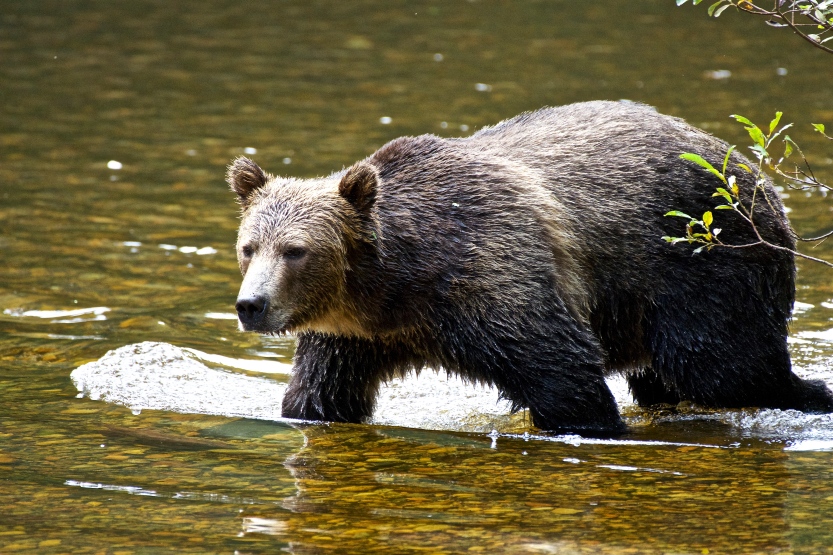
The day began with the offer of a refund and the prospect of leaving the Great Bear Rainforest without realizing a dream of seeing Grizzly bears in the wild. During the long journey back to Telegraph Cove, I contemplated how privileged I had been. Not only had I seen this, most majestic of creatures in the wild, I had experienced the bear’s salmon fishing behaviour that I had long dreamed of seeing.
If you enjoyed this post, please follow Incidental Naturalist.
Comments are welcomed.
Help others to connect with wildlife experiences by sharing this post on social media.
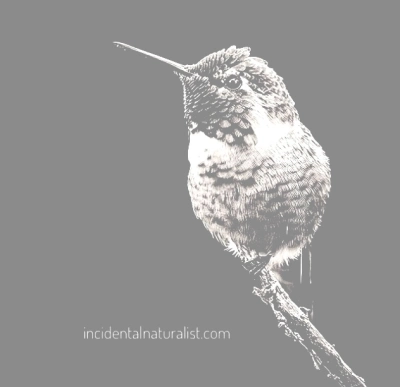


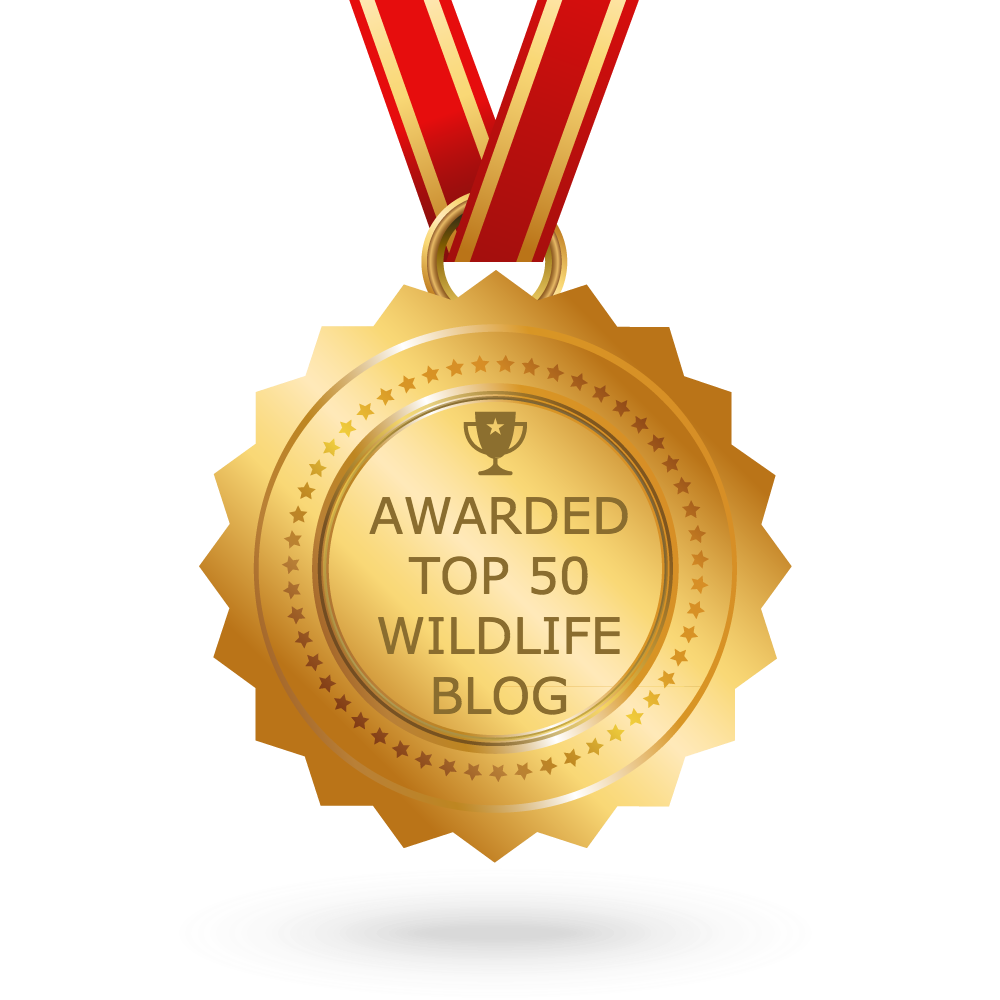

wow awesome pictures!
LikeLiked by 3 people
Amazing pictures! Talk about once in a lifetime – and you still got so many photos! Appreciate all the facts you research and add:))
LikeLiked by 3 people
Thanks Lara! It certainly was an incredible experience. I try to believe that it doesn’t have to be once in a lifetime 🙂 I appreciate your acknowledgement of the research and fact checking that it takes to pull an article together. 🙂
LikeLiked by 3 people
Fantastic photographs! Your commentary is spot on as well. Keep up the good work.
LikeLiked by 3 people
Thanks for the very encouraging comment!
LikeLiked by 2 people
I like that somuch I think I have clicked every like button on the screen
Wow mate good work I am having a feeling that it’s the best thing I have read in last few days
#awesome
LikeLiked by 2 people
Wow, thanks, that is great feedback!
LikeLiked by 1 person
Wow, davvero un’esperienza straordinaria, non solo per essere riuscita a fotografare questo animale straordinario, ma per essere riuscita a raccontare tutte le sensazioni che hanno accompagnato questa meravigliosa escursione, bellissimo articolo!
LikeLiked by 2 people
Thank you so much for that very kind feedback! 🙂
LikeLiked by 1 person
These photos are impeccable; they capture the beauty and a story of nature. I truly love this post!
LikeLiked by 2 people
Thanks for the kind comment! Very much appreciated. 🙂
LikeLiked by 1 person
That’s strange, normally it does not happen but it looks your subjects have come to pose for your clicks. Some seriously amazing work. I don’t think many can get these creatures to pose and you did so, just one word “Stunning”
LikeLiked by 1 person
Thanks so much for that kind comment! I was fortunate to be pointing my camera towards such a photogenic character. Right time, right place! 🙂
LikeLike
Amazing shots here, stunning! – Tasha
LikeLiked by 1 person
Thank you so much for that kind and encouraging comment, Tasha!
LikeLiked by 1 person
You’re more than welcome, I loved these photos!
LikeLike
I love natuer and the outdoors
LikeLiked by 1 person
Great content
LikeLiked by 1 person
Nice Post.
LikeLiked by 1 person
Thank you for such a lovely account of your experience with this amazing animal. I’m a passionate about nature and avid birder in South Africa. Reading your blog made me feel I was actually there.
LikeLiked by 1 person
Thank for the very kind comment! You certainly have great wildlife in South Africa! I hope some of my posts help to introduce you to birds from around the world.
LikeLike
Thank you for sharing this! Looking at the photos was great and I can only imagine how terrifying and exciting it must have been for you.
LikeLiked by 1 person
Thanks for the kind comment! I’m happy that you got a sense of my emotions.
LikeLiked by 1 person
Amazing Photos, Beautiful. Such an amazing experience. I was lucky enough to do this trip in September 16
Highlight of my year I think getting to see Grizzlies in the wild.
LikeLiked by 1 person
Thanks for the kind comment, Kate! You must have been just a few weeks ahead of me, as my trip was in October 16. I agree, it might have been the highlight of my year, too!
LikeLike
Hi David.. I’ve been waiting to see these pics! I’m the Aussie you met that day. I distinctly remember each moment you’ve captured here and I really hope I get to go again sometime. An absolute highlight of my trip and a day I’ll long treasure.
Keep up the good shots!
Therese
LikeLiked by 1 person
Hi Therese, great to hear from you! I know what you mean, I’d love to get back there sometime. I forgot to include the surprise appearance by ‘Bear Grylls’ 😉
Cheers
David
LikeLike
Hahaha.. I was tempted to mention that in my first message but didn’t want to be too cheeky! Nice to hear from you too 🙂
LikeLiked by 1 person
Loved reading about your adventures and seeing the photos of these awesome creatures. A few years ago I had the pleasure of spending the afternoon at Anan Creek Bear Observatory in Alaska. The jet boat ride from Wrangell, Alaska took a little less than an hour. The ride offered stunning views and added to the excitement of the day. The observation deck, built over the creek, is a short walk through the forest. We saw no bears on the walk, but that is a possibility. Once on the deck we were surrounded by black bears fishing. I didn’t know where to look first! At first, I did wonder what we were all doing here so close to these massive animals. I soon found, like you, they were only interested in the plentiful salmon entering the creek on their final swim. The highlight of the day was when a female brown bear emerged from the forest downstream with her FOUR cubs. Thanks for sharing!
LikeLiked by 1 person
Thanks for the great comment! It sounds like you had an amazing adventure. I’m so happy that you got to be in the company of black and brown bears, including cubs. Awesome! Im pretty keen to get to Alaska, so I’ll look in to Anan Creek. Thanks!
LikeLiked by 1 person
Your persistence paid off! Well written and compelling story with excellent photography too. I lived in Terrace, BC for a short stint in the mid 90’s before the Great Bear Rainforest area was protected. Very inspiring, and it is certainly on my wish list of places to visit once I make my way back out West. Thanks!
LikeLiked by 1 person
Thanks for the kind comment! I hope you get a chance to get back over there and see for yourself how eco-tourism is starting to build a new type of economy for the region. I hope to get back there myself some day. Cheers!
LikeLike
This was an incredible sounding trip! It sounds so amazing to see!
LikeLiked by 1 person
These are great pictures!
LikeLiked by 1 person
Thank you 🙏
LikeLike